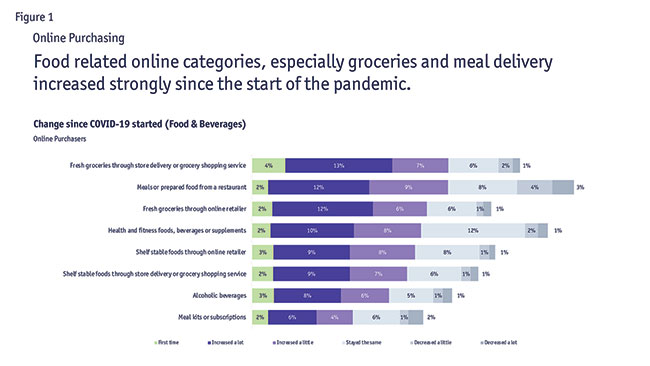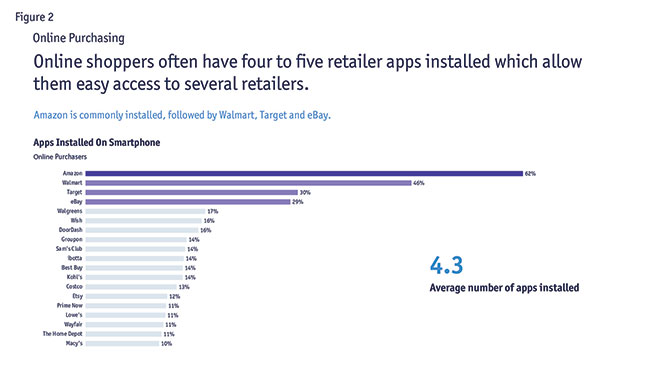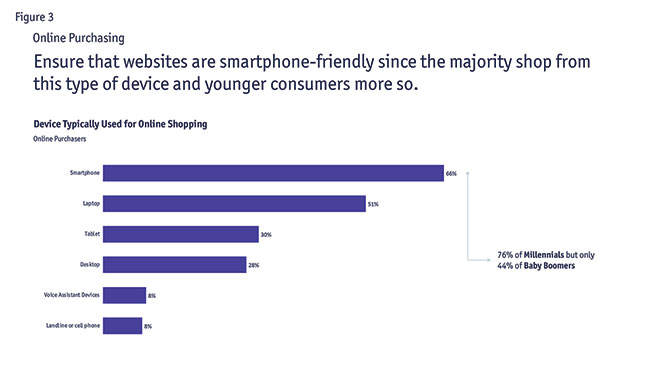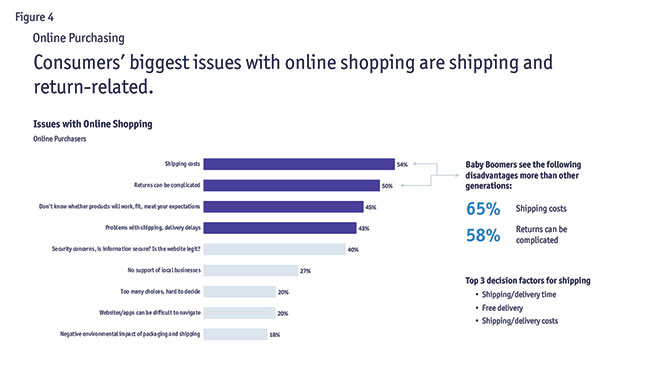Appreciate your business
Editor's note: Antje Sardo is senior research analyst at research firm GutCheck.
E-commerce has gained a significant role in consumer retail over the past few years and plays a huge part of today’s shopping experience. Online platforms like Amazon, Shopify and Alibaba have upended traditional brick-and-mortar retail stores and give consumers more choices and convenience than ever before. The shift to e-commerce, which was already well on its way, rapidly increased when the pandemic hit in March. Data from IBM’s U.S. Retail Index shows that COVID-19 hastened the move to e-commerce by five full years. Shoppers had no choice: They could either order their products online or risk potential exposure to the virus.
With many of GutCheck’s clients playing in the retail space, we wanted to examine the state of e-commerce after the initial peak of the pandemic and explore how consumer attitudes and behaviors may have changed. As the pandemic continues to impact our daily lives and extends with social distancing, mask requirements, online schooling and remote working – just to name a few – this new age of e-commerce will not be reverting back to pre-COVID-19 times and retailers will have to adapt or risk losing valuable customers to those who have.
In June, GutCheck surveyed more than 2,000 consumers who had shopped online in the past month. The survey was conducted online with respondents recruited though panels and our sample was balanced by gender, age, region and income to ensure fair representation when screening for online shoppers. The objective of the study was to explore not only how the pandemic impacts consumers’ current e-commerce habits but also understand how they’ll shop online after the virus subsides.
Here’s what we found.
Every generation increased
From Gen Z to Baby Boomers, consumers across every generation increased their online shopping and some consumers tried shopping online for the first time during the pandemic. While we know that Boomers may be a little more reluctant to acquire new habits, once they’ve established online shopping behaviors and are comfortable purchasing categories online they are likely to keep doing so – at least as an alternative option to in-store. An ongoing emphasis on social distancing may continue to motivate online shopping into 2021.
Consumers’ acceptance of ordering food and beverages online grew significantly since the start of the pandemic. Online ordering and delivery of fresh groceries increased the most, although takeout or delivery from restaurants and health and fitness foods and supplements remained the most popular online purchase categories within the food and beverage space (Figure 1).

About a quarter of online shoppers claim to have either increased their online fresh grocery purchases or tried using a grocery delivery service for the first time. Considering safety concerns and a collective effort on slowing the spread of the virus, it is no wonder that many consumers decided to avoid stores and opted to have groceries delivered right to their door or picked them up curbside.
This increase in grocery delivery or pickup is important to note. Historically, consumers have been slower to adopt fresh grocery online ordering and delivery when compared to other e-commerce categories. Retailers who already had an existing grocery e-commerce infrastructure in place benefited from this trend and even won new customers. And with parents having less time in their day to juggle shopping errands with increasingly hectic schedules, we saw the convenience of online grocery delivery and pickup grow in popularity.
Household essentials like paper goods and cleaners were other categories that showed strong online growth during the pandemic. This is certainly not surprising given the shortage of these products in traditional brick-and-mortar retail stores during the initial phase of the pandemic – consumers simply had to purchase these products online and in many cases were willing to pay a premium for them.
While the aforementioned categories were driven mainly by the fallout of the pandemic, consumers reported some increases in their online activity for every single product category we looked at. According to our findings, the most popular e-commerce product categories were clothes, shoes and accessories (53% of consumers shopped for these in the past month), electronics (46%) and personal care (45%).
Not overwhelmed
Despite having so many product and retailer options available when shopping online, consumers are not overwhelmed. Our research found that online shoppers typically have a good sense of what product they want to purchase and where to start their shopping journey. This emphasizes the value of prior positive e-commerce experiences. Positive online brand experiences, knowing which online retailers and sites work for them and seeing the top picks on search engines and aggregator sites help consumers find the products they are looking for.
Not surprisingly, Amazon is consumers’ preferred starting point for shopping online, with 58% of online shoppers stating their very first step was either going to Amazon’s website or using its app (which 62% of respondents have installed on their smartphones). Another 52% said they like to go directly to the website or app of a specific retail store, most often Walmart or Target, since those are preferred retailer apps (Figure 2). Forty-four percent of online shoppers say they typically use a general search engine, mainly Google. However, where consumers begin their online shopping journey varies greatly depending on the product or category they are shopping for.

Businesses that are already selling online and want to increase their sales, or those that are just getting started on their e-commerce journey, must take a consumer-centric focus and make an effort to be visible on the platforms their audiences are searching on. In many cases, this means being visible on Amazon and Google!
Fulfills a need
Convenience is the core value of online shopping. Consumers shop online because it is easy, fast, can be done at all hours of the day and there are tons of options right at their fingertips. Additionally, it allows complete social distancing. The majority of our survey respondents mentioned the pandemic, stay-at-home orders and social distancing as a reason for purchasing online. Within this new environment, e-commerce fulfills a need that consumers readily adapted to.
Every aspect of the online shopping experience must be convenient for the consumer. Convenience is what brings them to a site and a smooth shopping experience is likely to bring them back. However, any inconveniences or issues experienced when shopping a site online, whether with the search, product information, shipping, checkout or returns, are likely to deter consumers from coming back and they will seek alternative online shopping options since there are so many available.
One disadvantage of e-commerce compared to the in-store shopping experience is not being able to see and touch the actual product. Brands can overcome this by providing clear and detailed product information, close-up pictures and videos, plenty of consumer reviews and ratings that describe the pros and cons of the product and clear sizing and measuring instructions. The lack of clear information is not only an inconvenience but is also counterproductive when trying to build trust – be transparent and supportive in providing everything the consumer needs to make a purchase decision. Even if a chat option is offered, consumers prefer to have all the information they need to make their decision readily available.
Price is crucial, online even more so than offline. Price comparisons are easier online and consumers do take advantage of this. They expect a good deal online and with so many choices available it is very easy to search for the cheaper options. Keep this in mind when offering products and providing price information. Avoid hidden costs that add to the price point in shoppers’ eyes, especially when they are purchasing a single item that is not part of a bundle or full shopping cart. That said, in the food and beverage delivery space, consumers do indicate they are willing to make some price allowances for the added convenience.
Simple and efficient
In line with the convenience mantra, filtering, searching, viewing and scrolling should be as simple and efficient as possible. Our research emphasizes that the vast majority of consumers use smartphones to shop, especially those in the younger crowd. With that in mind, websites have to be mobile-friendly and easy to navigate on the smaller screen since not everybody downloads apps for every retailer.
Consumers are relying on multiple devices to make purchases online and may even use several of them in parallel during the shopping process. Even though 66% of e-commerce buyers use a smartphone to make purchases (Figure 3), only about 20% shop from smartphones exclusively. Fifty-one percent of respondents surveyed mentioned that they also regularly make purchases from a laptop and some also use tablets and desktops. 
This makes it critical that the shopping experience be consistent, offer comparable views and be equally convenient across the spectrum of available devices. Make device-switching easy and seamless to avoid irritating online shoppers. For example, while tablets may not be as commonly used as smartphones, consumers do use them to shop and some apps may not work equally well on a tablet as on a phone.
Apps and websites both have their pros and cons. Apps are oftentimes more convenient and user-friendly; they save consumers’ preferences and payment information, offer rewards or loyalty points, are designed to be easier to navigate on a smartphone than a mobile site and have strong security measures in place. However, consumers do have to take the time to install the app, which also takes up space on their device. Therefore, apps are more commonly used for repeat and frequent purchases from a retailer. The apps a consumer has installed are clear indications of the retailer sites they are considering.
Websites are more of the default option for consumers who are simply browsing a site but may not necessarily be loyal to it. Given the broad use of smartphones, websites must be mobile-friendly and easy to navigate on both small and large screens to keep online shoppers engaged. There is a benefit of using a web browser to shop since payment information is saved, it can be easier to compare products side-by-side, there is less scrolling and using a mouse and keyboard to navigate can be easier. This is especially important to older generations.
Having grown up with smartphones dominating numerous aspects of their lives, younger consumers are more prone to use these devices when shopping online. They are constantly online and are used to juggling several sites, apps or windows, easily making selections and shopping in this environment. This means they are shopping around, exploring and comparing more than older consumers. They are also more likely to walk away from a purchase and find another seller if things do not go their way.
Still pain points
While e-commerce has exploded in popularity and brands and retailers have made major inroads in expanding their e-commerce experience, there are still pain points for online shoppers that must be addressed to keep them coming back. These include checkout and payment, shipping and returns (Figure 4). If not handled correctly, the issues in each of these areas can cost retailers and brands not just the sale but the customer entirely.

Similar to the entire online buying process, payments must be convenient, fast and smooth. Any issues or hiccups experienced can impact the sale – therefore avoid any surprises, such as added costs or fees that show up at checkout. It is so easy for consumers to walk away from the online shopping cart – they don’t even have to click a button. Many respondents told us they have no problem leaving the shopping cart if they do not like the shipping options, the final price, the payment options or if their coupon or discount codes are rejected. And if possible, avoid redirecting customers to another site for payment. Even if that site is entirely legitimate, some find this suspicious.
Our study confirmed that payment methods like PayPal and debit or credit cards make up the majority of online purchases. However, other payment methods like Apple Pay and Google Wallet must also be accounted for, especially with sites that draw in younger consumers. Whether the payment information is already conveniently saved in an app, browser or has to be typed in, all options should be readily available since consumers have different preferences.
When it comes to paying for purchases, younger consumers stated they are comfortable using a variety of payment methods, while Baby Boomers clearly prefer credit cards. Boomers are still prepared to type in their card info every single time, whereas younger consumers are comfortable having their payment information saved in a browser or app.
Again, it is critical that retailers take a consumer-centric approach and offer the shopper their preferred payment method and not force them to comply with limited options.
Shipping plays an outsized role when it comes to e-commerce. In fact, the two biggest issues with online shopping are shipping costs (54% of survey respondents took issue with this) and an unsatisfactory return process (50%). Many consumers have had bad experiences with shipping or returns and are trying to avoid having similar experiences again. Shipping and delivery are so critical to the e-commerce journey that 32% of women and 41% of Baby Boomers state they will not even buy a product if they do not like the shipping or delivery options available to them.
With this being the case, it is no surprise that Amazon dominates e-commerce. While not perfect, its free shipping offers and breezy returns are a huge draw for consumers, especially given the broad reach of Amazon Prime. Brands that do not offer free shipping with a purchase should at least have an option for consumers to achieve free shipping – for example, by offering a certain, achievable price threshold in their cart.
With its abundance of free shipping and delivery offers, the pandemic has spoiled consumers and reset expectations in this regard. If not free, consumers will view shipping costs as part of the online product price and evaluate whether it is really justified.
Adapt to new environment
Prior to 2020, e-commerce was already experiencing major growth but COVID-19 caused it to become even more ubiquitous. Our research confirms that food and beverages were the online categories experiencing the biggest growth in recent months, although all online categories researched grew as the pandemic raged. It is important that retailers looking to adapt to this new environment, increase sales and grow their consumer base offer easy-to-navigate websites and apps, competitive pricing, free shipping options, simple return processes and be open and upfront with any product and shopping information.
We anticipate seeing continued e-commerce demand and growth while the pandemic lingers and as we head into the holidays and 2021. While it may not achieve the popularity it did at the very height of the pandemic, and traditional brick-and-mortar stores will bounce back to some extent, consumers are now much more comfortable and familiar with online shopping than before and appreciate its convenience as they try to balance their busy lives with the changes 2020 has brought them.
